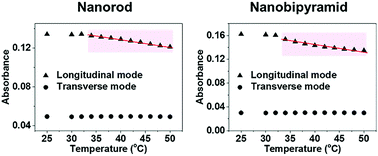Poly(N-isopropylacrylamide) capped plasmonic nanoparticles as resonance intensity-based temperature sensors with linear correlation†
Abstract
Thermosensitive polymer capped plasmonic nanoparticles are novel thermal nanofluids with potential sensing applications. Previous research efforts have been focused only on monitoring plasmonic resonance peak shifts caused by aggregation as temperature varied. However, to date, no linear relationship between the resonance peak shift and temperature has been established. Here, we systematically investigate how plasmonic resonance peak intensity responds to solution temperature using poly(N-isopropylacrylamide)-capped gold nanorods (AuNRs) and nanobipyramids (AuNBPs) under aggregation-free conditions. Our results clearly reveal the linear correlation between longitudinal resonance peak intensity and solution temperature for both types of particles. AuNBPs have sharper ends than AuNRs, resulting in greater thermo-sensitivity due to the presence of stronger ‘hot spots’. Further analytical and numerical studies demonstrate chemical interface damping effects by surface-capping ligand configurational changes and these theoretical results agree well with our experimental observations. In addition, this damping-based sensing is reversible with excellent durability, indicating the possibility of potential real-world temperature sensing applications.



 Please wait while we load your content...
Please wait while we load your content...